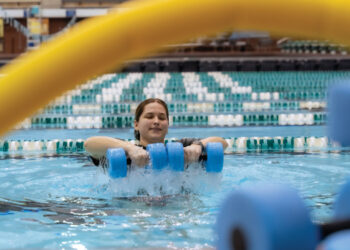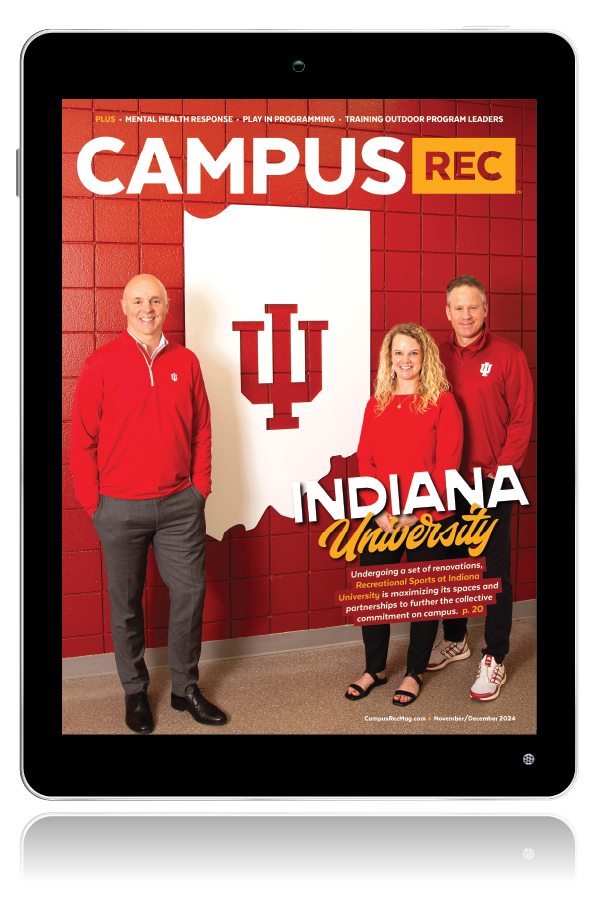The 2020 pandemic lessons learned are many. Three rec center directors share their top takeaways from the past year.
What do I do now?” was the question many college students asked during late March of last year.
It was also the title of the first virtual discussion hosted by Embry-Riddle Aeronautical University’s (EAU) Intramural and Recreational Sports. As the Fitness and Wellness Center on campus closed mid-spring semester due to COVID-19, the department — like many others across the U.S. and the world — pivoted to offer its recreation programs virtually.
Greta LeDoyen, the director of the ERAU Fitness and Wellness Center, said about 10 students showed up to the first virtual discussion, many of them student employees. “We shared tips we had been using at that time and things they could do on their own,” she said.
Like most, she and her team experienced figuring out how to offer things virtually. That uncertainty in how to serve students from afar was one of the biggest challenges of the pandemic that Shauna Sage, the director of Campus Recreation and Wellness at Western Carolina University (WCU), said they initially faced.
“It was important to embrace the uncertainty [in how we were going to serve students moving forward] and view it as an opportunity to affect students differently, to get creative and to try new modalities of offerings,” said Sage.
Once closed, WCU began to offer social media and wellness challenges, running programs, esports, a YouTube workout channel and more.
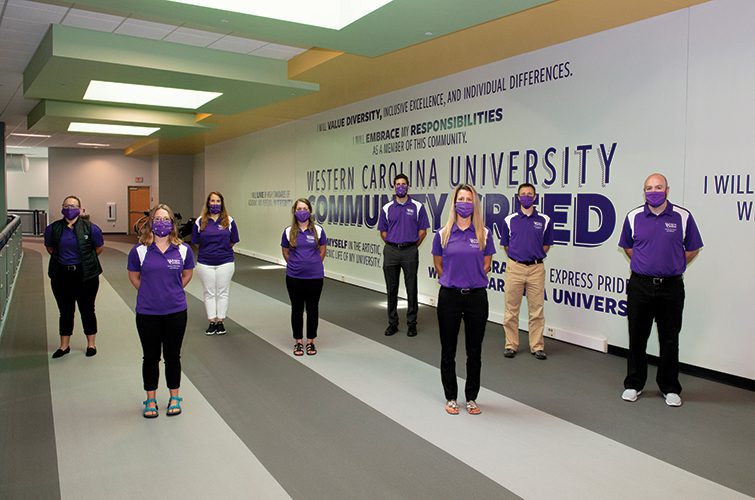
For the University of Oklahoma (OU), Zoom was largely used with wellness and fitness classes, wellness coaching, and personal training. Plus, Amy Davenport, the director of Fitness and Recreation, said they offered virtual intramural sports and a 5K series. “We wanted to ensure our OU community continued to have the opportunity to stay on track with fitness, stress relief and engagement with each other,” she said.
With the unknown having been embraced, Davenport shared one of the biggest 2020 pandemic lessons was the ability to be fluid and accept fluid planning. “Never hesitate to change for safety and listen to members’ needs,” she shared.
But the unknown didn’t remain isolated to initial closures. It bled into the 2020-2021 school year, with schools debating on reopening, safety guidelines and more. As such, Sage said the entire team had to plan for multiple contingencies in order to adapt quickly. Plus, this allowed them to communicate to their community in a timely manner.
Some of the biggest 2020 pandemic lessons for LeDoyen have been learned in coming back to campus. Reopening in Fall 2020, the Fitness and Wellness Center instituted a wellness check as students entered, and staff gave each a spray bottle of disinfectant and a towel, instructing they were to clean before and after use. Her department also adapted Appointy as its reservation system after seeing hour-long wait times to get in.
But the most important aspect has been educating students from how to get used to wearing a mask while working out to why they need to reserve their spots. “They are in control of their own health and they are in control of the health of those around them,” said LeDoyen. “Because if there is an outbreak, the situation here would be very different, and I think they cherish and value their opportunity to be here.”
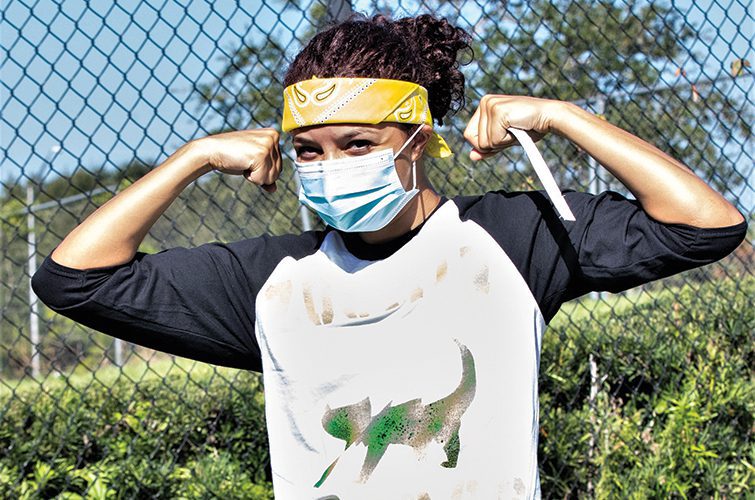
One interesting thing that has developed from COVID-19 is the partnerships occurring between LeDoyen’s department and other departments on campus. Since offering outdoor trips — like hiking, paddle boarding and snorkeling — other programs want to give their own students the ability to connect together without masks.
Now, LeDoyen and her team are leading 10-person groups for three different departments on various local trips. “They sell out in a day or less, depending on the marketing,” she said.
Like many others, OU implemented 12-foot distancing between equipment pieces, cycling class bikes, etc. And although Davenport said moving the equipment was a feat, that wasn’t the biggest challenge during preparing to reopen. It was hiring.
Each student position had to be rehired, and there was additional training for COVID-19. In order to not tax full-time employees, the department used the university’s online academic class platform to develop training videos, quizzes and records of completion.
“With training provided through this system, it really helped full-timers continue hiring and preparing for the fall with assurance student employees were receiving proper training,” said Davenport.
In fact, one top lesson from the pandemic Davenport shared was to take care of yourself, something the online training did for full-time staff. “We work so hard to take care of members,” she said. “[We need to] lead by example and take care of ourselves, too.”
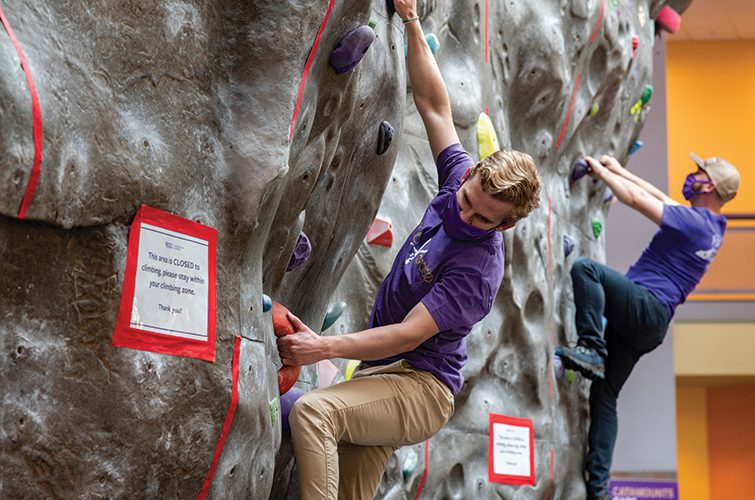
Another lesson learned dealt with communication. LeDoyen said ERAU pledged to communicate all plans and activities to its community in a transparent way. There is a special web portal for all COVID-19 information, as well as the weekly university test results updates.
Both Davenport and Sage echoed LeDoyen’s lesson learned of critical communication with set expectations. This is not only with staff but with your users as well, for gone are the days of communicating through smiles. “Clear communication and multiple forms of communication are more important than ever before,” said Sage.
Finally, perhaps the biggest but unnamed lesson from 2020 is the role of campus recreation, specifically in offering a sense of normalcy in a world where it’s rarely been found after March.
People in masks are everywhere. Cleaning regulations are strict. Travel is limited. Working remotely is a reality. But, you can still workout, even if only outdoors. That sense of normalcy for LeDoyen has been worth going through all the other 2020 pandemic lessons to be learned.
“The fitness center seemed to really take on this sense of normalcy,” she said about reopening. “Even though you still had your mask on and you were still spaced out, due to the nature of a weight room there was just this different connection.”






